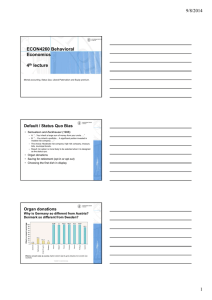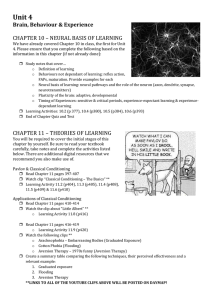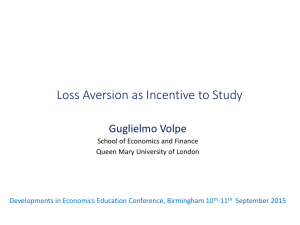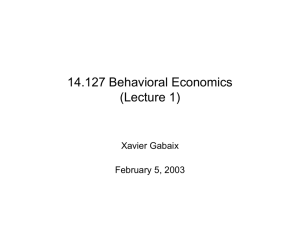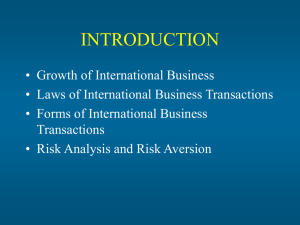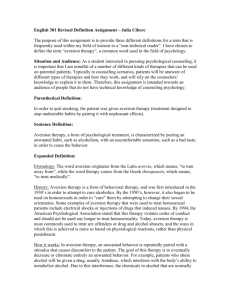Fourth lecture Mental accounts and more on loss aversion
advertisement
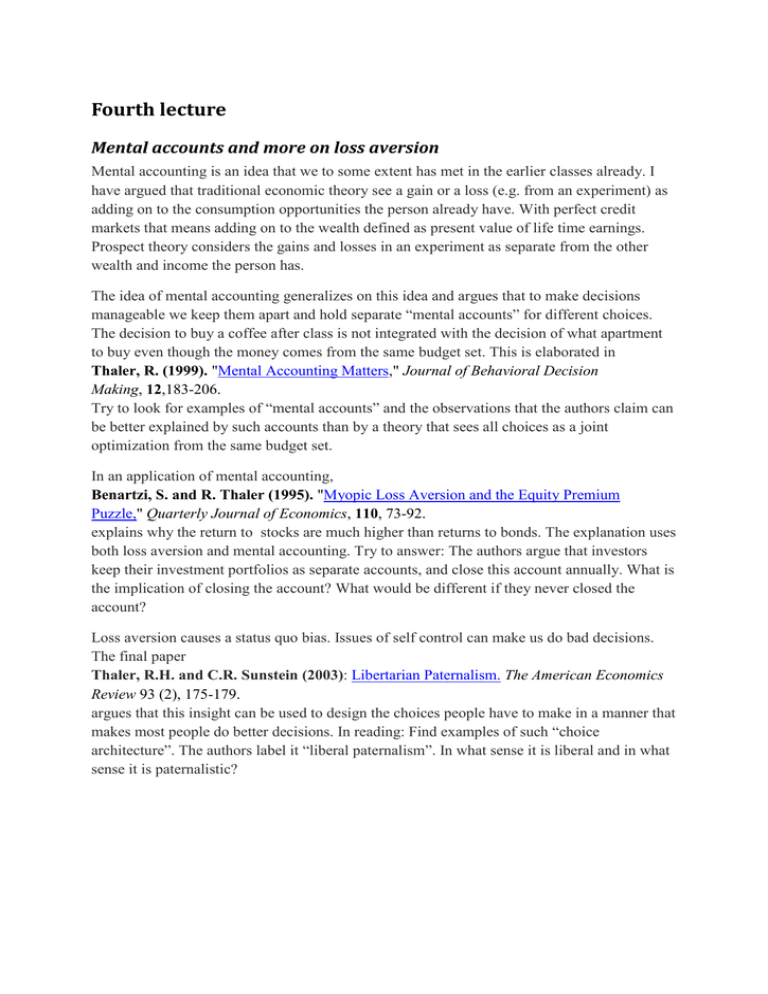
Fourth lecture Mental accounts and more on loss aversion Mental accounting is an idea that we to some extent has met in the earlier classes already. I have argued that traditional economic theory see a gain or a loss (e.g. from an experiment) as adding on to the consumption opportunities the person already have. With perfect credit markets that means adding on to the wealth defined as present value of life time earnings. Prospect theory considers the gains and losses in an experiment as separate from the other wealth and income the person has. The idea of mental accounting generalizes on this idea and argues that to make decisions manageable we keep them apart and hold separate “mental accounts” for different choices. The decision to buy a coffee after class is not integrated with the decision of what apartment to buy even though the money comes from the same budget set. This is elaborated in Thaler, R. (1999). "Mental Accounting Matters," Journal of Behavioral Decision Making, 12,183-206. Try to look for examples of “mental accounts” and the observations that the authors claim can be better explained by such accounts than by a theory that sees all choices as a joint optimization from the same budget set. In an application of mental accounting, Benartzi, S. and R. Thaler (1995). "Myopic Loss Aversion and the Equity Premium Puzzle," Quarterly Journal of Economics, 110, 73-92. explains why the return to stocks are much higher than returns to bonds. The explanation uses both loss aversion and mental accounting. Try to answer: The authors argue that investors keep their investment portfolios as separate accounts, and close this account annually. What is the implication of closing the account? What would be different if they never closed the account? Loss aversion causes a status quo bias. Issues of self control can make us do bad decisions. The final paper Thaler, R.H. and C.R. Sunstein (2003): Libertarian Paternalism. The American Economics Review 93 (2), 175-179. argues that this insight can be used to design the choices people have to make in a manner that makes most people do better decisions. In reading: Find examples of such “choice architecture”. The authors label it “liberal paternalism”. In what sense it is liberal and in what sense it is paternalistic? 2/5/2013 ECON4260 Behavioral Economics 4th lecture Mental accounting, Status Quo, Liberal Paternalism and Equity premium. Applications • Rabin: EU implies risk neutrality in small gambles • Prospect theory predict risk aversion in small gambles • Keeping 10 000 NOK in stock is a small/modest gamble – EU predict almost risk neutrality – We observe a huge risk premium • To tell this story we also need ‘mental accounting’ • Liberal paternalism – Loss aversion induces a status quo bias. – Other reasons for such a bias – Can make people choose what is good for them - without coercion Institutt for statsvitenskap Default / Status Quo Bias • Samuelson and Zeckhauser (1988): – A: ”…You inherit a large sum of money from your uncle. …” – B: ”… You inherit a portfolio… A significant portion invested in modest risk company. …” – The choice: Moderate risk company; high risk company, treasury bills, municipal bonds. – Result: An option is more likely to be selected when it is designed as the status quo. • Organ donations • Saving for retirement (opt in or opt out) • Choosing the first dish in display 1 2/5/2013 Explaining default effects • Effort – Becoming a organ donor requires effort (as does opting out) • Implicit endorsement – I ask “does anybody disagree”, it may have been interpreted as “you better not”. • Coordination – “Raise your hand” may be a coordination game – “I want to answer the same as everyone else” – “Nothing” is the best prediction of what others will do • Besides, I can raise may hand after the others • Loss aversion – It is often natural to expect status quo. Institutt for statsvitenskap Fairness • Q 1a: “A shortage has developed for a popular model of automobile, and customer must wait two months for delivery. A dealer has been selling the car at list price. Now the dealer prices the model 200 $ above list price” – Acceptable (29%) Unfair (71%) • Q 1a: “... A dealer has been selling the car 200 $ below list price. Now the dealer prices the model at list price – Acceptable (58%) Unfair (42%) Liberal paternalism • We need defaults – – – – Organ donor or not? Many left without a license when they had to choose (no default) Join savings plan or not There is some food on the first spot • It is easy to opt out – no one forced (Liberalism) • Knowing that more people pick the first dish – Should the healthy or unhealthy be picked first? (Paternalism) • Caveat – Suppose one option is good for society another for the individual • Littering, military services… – Is it acceptable for the government to induce individuals to act against their own self interest, using subtle means like: defaults? Økonomisk institutt 2 2/5/2013 Real rates of return • Highly dependent on risk – Stock return about 8% – Long term bonds about 3.5% – USA Treasury Bills (short term) 1% • Difference too large to explain with risk aversion • One argument: It is loss aversion • NOTE: THERE ARE OTHER THEORIES – – – – Habit formation Transaction costs Non-expected utility Unknown probability distribution for future consumption Mental accounting • Imagine that you are about to purchase a jacket for ($125)[$15] and a calculator for ($15)[$125]. The calculator salesman informs you that the calculator you wish to buy is on sale for ($10)[$120] at the other branch of the store, located 20 minutes drive away. Would you make the trip to the other store – A: Numbers in ( ). Most will make the trip – B: Numbers in [ ]. Few will make the trip – Both cases save $5 at the cost of a 20 minutes trip. • Why do people choose differently in A and B? Mental accounting • To simplify decisions we isolate different decisions. Keep separate mental account – The calculator purchase is seen isolated – We do NOT focus on the global preference question • Travelling 20 minutes • Versus saving 5 dollars 3 2/5/2013 Opening and closing accounts • Purchase a stock at price P0. • Sold at time t (mental account closed) • If Pt<P0, we would close with a loss – Utility function is locally convex (risk seeking) – Accepting the loss is painful – Thus: Keep losers • If Pt>P0 – Utility function is concave (risk aversion) – We can close the account without losses – Thus: Sell winners • Observe a tendency to keep loosers and sell winners • Rationality predicts: Optimal to sell losers (tax deductible) Successive lotteries • Samuelson’s colleague – Turned down (-100,50%,200,50%) – Would accept the same lottery played 100 times “as long as he did not have to watch the bet being played out” – Two such lotteries = (200,25%;100,50%,400,25%) Evaluation with prospect theory • Consider value function: – v(x)=x for x≥0 but – v(x)=2,5x for x<0. • Once: -2.5*100*50%+200*50% = - 25 • Twice, watching: -25 + (-25) = -50 • Twice, not watching : -2.5*200*25%+100*50% +400*25% = +25 Institutt for statsvitenskap 4 2/5/2013 Equity Premium Puzzle • Mehra and Prescott – Equity return: 8% (real) – Treasury bills: 1 – 0.5% (real) – Consumption is growing, 2% per year • Marginal utility declining • Risk aversion required, (rra=30) – Lottery in future consumption (200 000, 50%, 400 000,50%) ~ (204 500) – “No one is that risk avers.” If it is loss aversion, So what? • A discount rate of 8% or 1% for public projects matters a lot. – The major issue in the economics of climate change • Private and public project may have similar risk • But what are the losses in public projects? • Should prospect theory be a normative theory – How often should we evaluate public projects? • If we should be consistent with EU – How do we account for the large deviation from EU in the asset market Alternative explanations • Nonexpected utility (Kreps and Porteus) – Preference over resolution of uncertainty • When will you know whether you won? – Can explain both interest rates, but still need high risk aversion. • Habit Formation (Constantinides) – Requires very high (implausible?) degree of habit formation. • Fat tailed distributions (Weitzman) – Put much more weight on extreme outcomes than standard normal distribution. 5 2/5/2013 Explaining the equity premium puzzle • How is a stock kept 36 months valued – – – – – As 36 bets (watching the bets played out) As almost 1000 daily bets (watching) As 12 quarterly bets (watching) As 3 yearly bets (watching) As one bet (or no watching) • To explain the eq. prem. paradox, we must assume that it is seen as 3 yearly bets. – Benartzi and Thaler argues that this is the most natural. E.g. tax reports are due yearly. Why does it matter when mental accounts are closed? • Consider an asset held for two years – First year yield a nice +1000 gain – Second year yield a bad -500 loss • Evaluated as one account – Total gain + 500 is good • Account closed every year: – – – – First year a benefit + 1000 Second year loss value 2.5(-500)=-1250 Net value -250 Perceived as a bad choice Empirical evidence • Thaler 1997 – Subjects allocate investment between high an low risk fund • ”Monthly” treatment – 200 decisions binding for 1 period • ”Yearly” 25 decisions, binding 8 periods • Much more investment in risky funds in yearly treatment • Gneezy, Kapteyn and Potters (2008) – – – – – Trading in lottery tickets High frequency: Ticket last and traded each period Low frequency: Tickets last tre periods and traded every third period. Tickets higher price in Low than High But price exceed expected value! • Eriksen and Kvaløy find similar for fund managers investing others money. 6 2/5/2013 The critique • Traditional theory have one parameter, risk aversion, with a narrow plausible range • The value function of CPT is similarly fixed • But the choice of reference point adds a degree of freedom – With two parameters we can track two observations – No way to check the plausibility of the last parameter. • On the other hand: the theory generate new predictions supported in lab. What if this is the correct theory? • What interest rate should we use – For public project – Evaluate environmental policy (climate change) • Is Prospect theory a good theory of how we ought to act? – What are the losses of climate abatement? – Or is expected utility a better normative theory? • Are investors overly reluctant to accept risk? – Should government stimulate risk taking? Summary: Behavioral decision theory • Imperfect probability assessment • Over-weighing low probabilities – Buying Lotto tickets • Loss aversion and endowment effect – Explain risk aversion in small gambles (and perhaps also equity premiums) – Kinked indifference curves – Status quo bias 7
